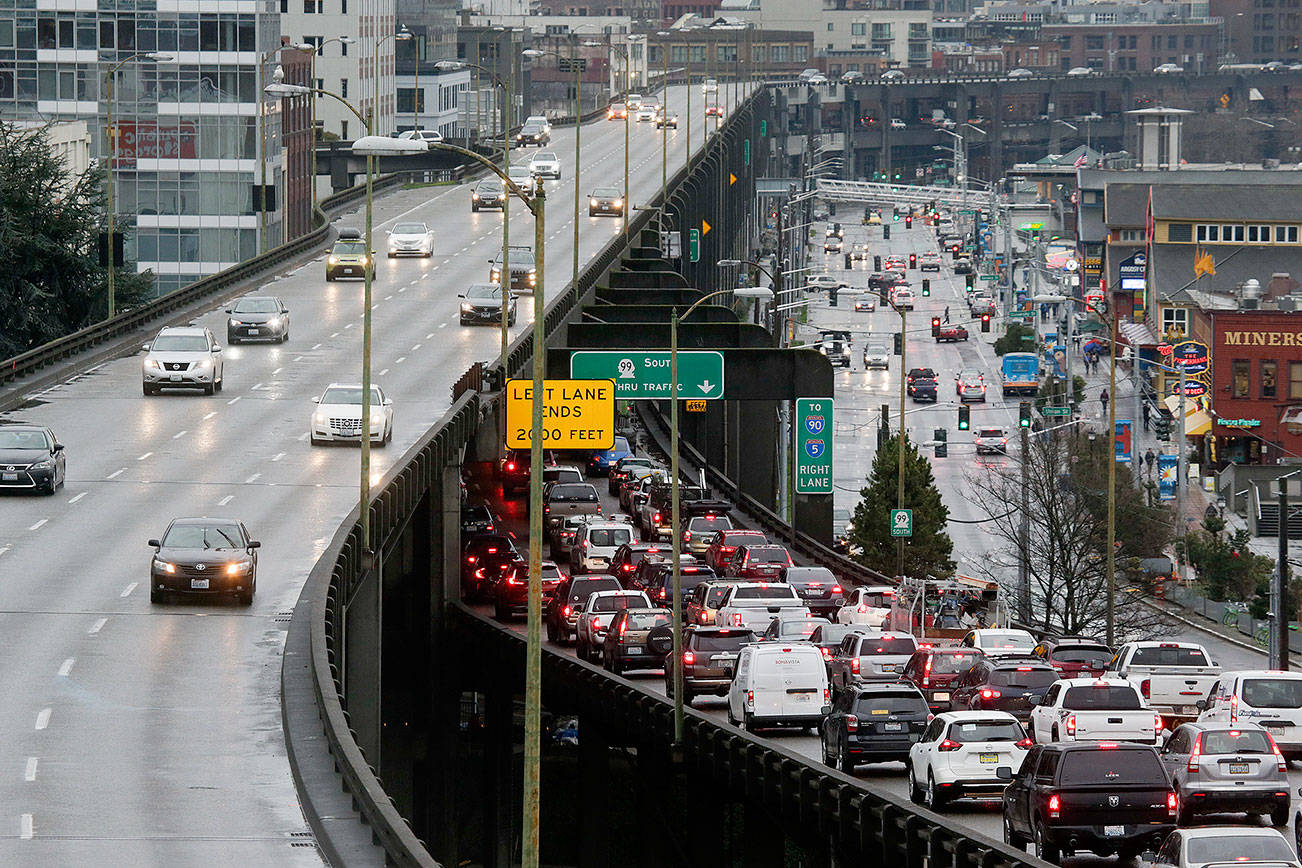After a decade of planning, the date was set for Seattle’s Alaskan Way Viaduct to shut down forever, but one questioned remained unanswered when the demolition began on Jan. 12: Are commuters ready for the longest major highway closure in the city’s history?
“Three weeks is a long time to have a highway closed in Seattle, we’ve never done that before,” said Bart Treece, WSDOT Northwest Region communications manager. “For folks who’ve grown up and lived in this area, this is a long time coming, so it’s an exciting time here.”
One week into the “Viadoom” closure (the unofficial moniker adopted by the public), officials say the transition has been smooth other than some longer commutes and earlier slowdowns. According to Treece, traffic moved pretty well and some commuters saw an average difference of about 10 minutes in each direction.
Prior to the closure, Treece and the Washington State Department of Transportation’s (WSDOT) communications team worked for months in an effort to inform locals on the potential impacts. That effort and the locals’ reaction to the closure has been a large part of the smooth transition, Treece said.
“It wasn’t a surprise that the viaduct was going to close for three weeks,” Treece said. “The folks who are traveling are really giving us a huge hand as far as keeping stuff moving. Those adjustments, [even] if it’s something small like telecommuting for a day, car pooling or just delaying discretionary trips, those things really add up and have made a huge difference.”
Despite the manageable impacts during week one, WSDOT is urging locals not to revert to old commute habits as the new state Route 99 tunnel won’t open for another two weeks and several on ramps and exit ramps will open even later.
“We ask that everyone keep doing whatever it is they are doing as reverting to old habits will make a challenging traffic situation much worse,” said Laura Newborn, spokesperson for WSDOT. “We still have at least two more weeks to go with no viaduct and no tunnel — and while we’re pleased people seem to have heeded the warnings — it’s way too early to call this a success.”
Manageable impacts
Impacts on the Eastside have been equally manageable. Apart from a large I-405 backup on Jan. 18 due to a crash, there have been only an expected increase in delays and slowdowns around the state Route 520 and Interstate 90 bridges.
“We have seen some delays coming from the Eastside… for the most part we are seeing things flow pretty smoothly,” Treece said. “I think people understand that this has regional impacts — a highway closure in Seattle does have a ripple effect on other highways connected in the area.”
WSDOT has been working closely with the Washington State Patrol to increase the number of response teams that clear out breakdowns and accidents, which has helped minimize the impacts of increased traffic alongside efforts from commuters.
The viaduct carried about 90,000 vehicles everyday, according to WSDOT numbers, and 30,000 bus passengers on top of that.
Efforts to minimize highway traffic may not extend to a large shift towards public transit commutes as passenger loads on Sound Transit busses and trains have been normal, according to Sound Transit spokesperson Kimberly Reason.
“There have been no notable ridership impacts thus far on our services,” Reason said. “Though as Laura indicated, there’s still two weeks to go for the closure and it’s important commuters not revert to old patterns.”
Engaged commuters
Treece and the WSDOT communications team continue their public outreach efforts and hope commuters continue to stay updated on the daily traffic flow.
“It’s a team effort here, and that team extends to the traveling public,” Treece said.
WSDOT constantly updates its Twitter accounts with accidents, slowdowns and travel times. The department also has numerous travel cameras commuters can access through www.wsdot.wa.gov and a mobile app to help determine the best route options.
“There’s a lot of information out there for people to help guide their decision making when it comes to when they travel and how they travel,” Treece said. “What folks do with that information is what really has an impact on the roadways.”
Treece particularly recommended commuters get up early to check the traffic conditions and correspondingly adjust their daily travel routes.
“It’s a long time to ask people to do something different,” Treece said. “We’re hopeful that people continue to stay engaged and continue to make different choices because we still have a long way to go.”
Stay wary
Newborn also credited commuters for partially helping with a manageable transition into the closure, but ultimately, she said it’s difficult to tell how they’ve changed habits.
“We know more people are taking the water taxi and more people are using bikes, as we can measure that,” Newborn said. “[However,] we can’t measure how many people are flexing their hours, working from home, eliminating discretionary trips to Seattle or even taking vacation time.”
While the “Viadoom” nightmare has been brighter than expected within the first week, traffic jams still loom as locals decide how they’ll commute during the closure’s peak.
“We’re hopeful that people look to this week and build off of this success… continue to stay plugged in,” Treece said. “Largely the system kept moving, there were some above average travel times in some areas… but overall it was pretty manageable.”



